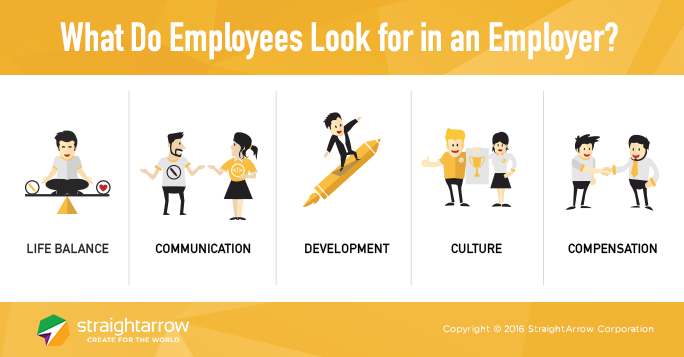
The contemporary labor force are infamous for their professional polyamory: serial short-term stints with employers whom they ditch at the first sign of a better offer. How much of this is myth and how much is reality is subject to debate, but it’s worth noting that Microsoft has shelled out billions of dollars to acquire LinkedIn, a social media platform whose very premise is, as New Yorker writer Nathan Heller says, “that it is possible to flirt with a C.V.”
Some businesses simply accept this as truth and shuffle their rosters regularly. But for businesses that prize capable, well-trained, and committed employees, breaking this trend can prove frustrating. Oftentimes, the policies required to entice new employees to stay are those that company veterans refuse to countenance; while the rules these mainstays uphold are what new hires call backward and counterproductive.
Much research on human resources has focused on the things that influence employees in choosing a company to work with and sticking with it. Businesses have resorted to everything from relaxed dress codes, to in-office entertainment, to vague attempts at adding ‘fun’ into their corporate culture—all while still facing a steady stream of resignation letters. So what’s the secret? Recent studies point to certain factors as the major influences on what make people stay: life balance, communication, development, and culture.

Life Balance
No longer ‘work-life balance’—which seems to imply work is as important as all else in life together—this motivator consistently figured in employees’ major concerns in surveys worldwide. Contemporary employees favor jobs that allow them flexibility to pursue things beyond work, such as relationships, hobbies and personal development. This is especially true in younger workers, many of whom grew up under the disembodied gaze of parents too busy with work to see them at home.
Improving life balance typically involves allowing flexibility in work hours and locations. This finds its most extreme expression in what is called a results-only work environment (ROWE). Companies that implement this allow workers to work wherever, whenever, and for however long they want, provided they are able to produce results. More moderate solutions, of course, might allow workers flexibility in schedules, such as the option to offset start and end times by an hour; or allow for telecommuting on certain days of the week.
Communication
Employees value open and frequent communication. This doesn’t simply mean idle banter, however, among colleagues, and between supervisors and their charges. Companies should strive for meaningful communication of goals, strategies, and feedback. Managers should engage workers in conversation on why they do certain tasks, why these must be done in certain ways, and how they can be done best.
For this reason, successful managers are often likened to coaches. It would be a poor coach that told his team to win a game without telling them how, or helping them hone the skills needed to do so. A good coach provides a team with a clear purpose and helps them reach their objectives individually and collectively. Companies that offer this kind of management will attract and retain employees much better.
Development
Another factor that often tops surveys on employee motivation is development: the opportunity to advance in a career or to acquire skills and knowledge necessary to do so. Fortunately for managers, people with such motivations are typically worth keeping in the long-run.
Sending people off to training, seminars or further education satisfies their needs for development. Companies often fear that employees will leave after reaping the benefits of such generosity, but keep in mind that these measures should be paired with others, like clear communication, to get an understanding of why they want to pursue these skills and to reassure them that they will be able to put them to use, and reap the benefits of doing so, by staying with the company.
Be sure, also, to provide employees with information about their options in career advancement. Not every employee who takes another offer does so because of an exhaustive comparison of benefits—sometimes they do it because the employer they left didn’t give them enough certainty about where they were going.
Culture
Broadly speaking, culture covers shared values and practices. In terms of work, this might include a company’s core values, mission and vision. Often more relevant, however, are how these translate into everyday routines. How do people interact with each other? Is there an emphasis on hierarchy? Do people often put in extra hours? The day-to-day experience of work can either attract or repel, to a great extent, depending on how it aligns with a specific person’s inclinations.
Beyond this, people also look for companies that make them feel like part of a grander cause. If a business advocates, through CSR or through its operations, for a cause that a person supports, he or she would be more likely to stay.
Compensation
We didn’t mention this one at the start, but as Meddius CEO Jeff Gunther puts it, compensation is done right when it “take[s] the issue of money off the table.” Companies shouldn’t use extra money as a motivator—as with businesses that offer large commissions, but low basic pay—rather, it should be used to provide employees with security. A modest monthly income, health benefits that cover dependents, and adequate leave credits can all set your workers at ease. When you offer them certainty in meeting their needs, their eyes—and resumes—will be less likely to wander.
With all that said, the currents that drive careers are stronger than the whims of individuals. Economic changes mean permanent positions are in shorter supply than before, and the career-building narrative now prizes instances of being ‘pirated’ by companies with a more aggressive offer. Faced with realities like this, sometimes people have no choice but to go with the flow.
To learn more about creative process outsourcing—an option for expanding your business’ capacity in the shifting business landscape—download our eBook.




Comments